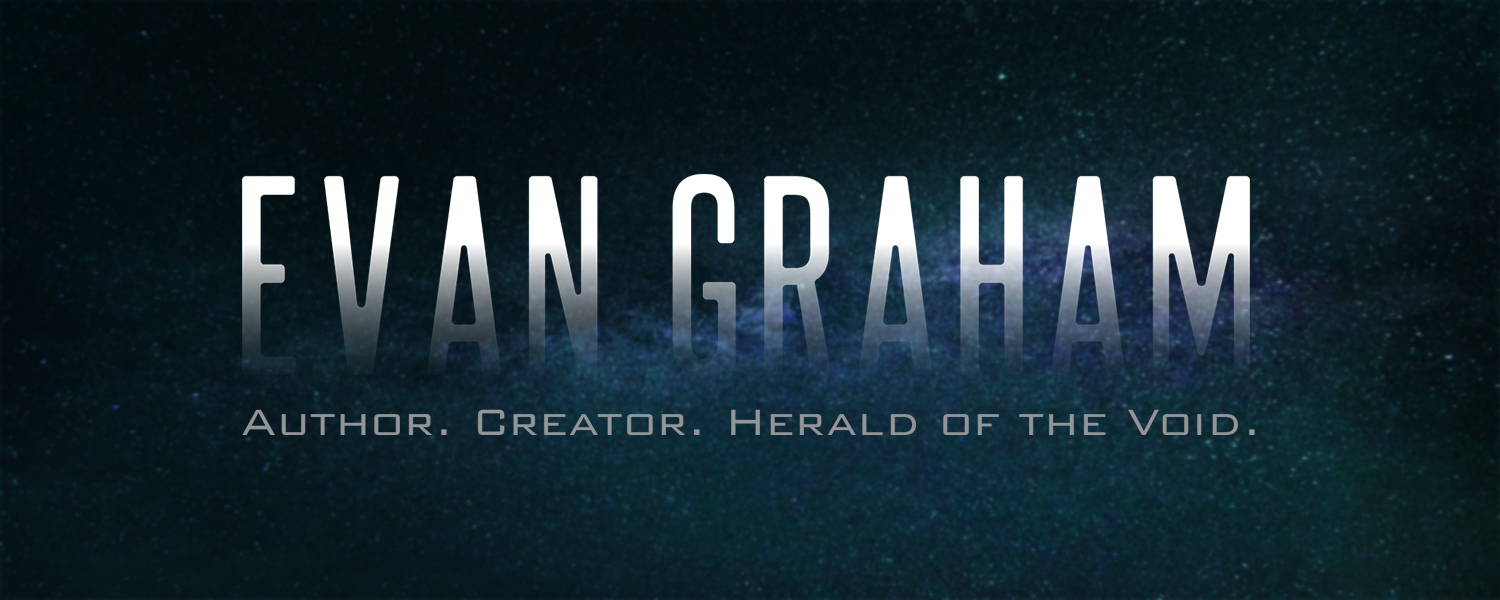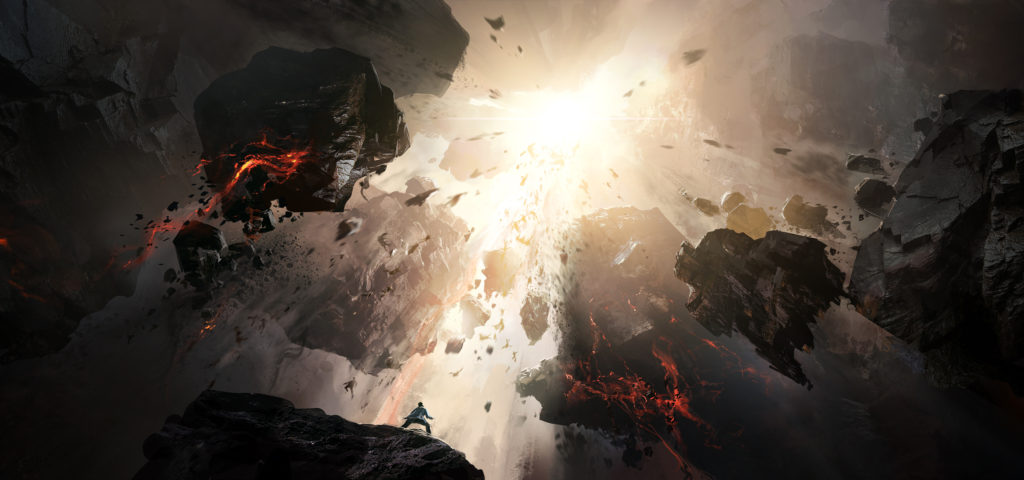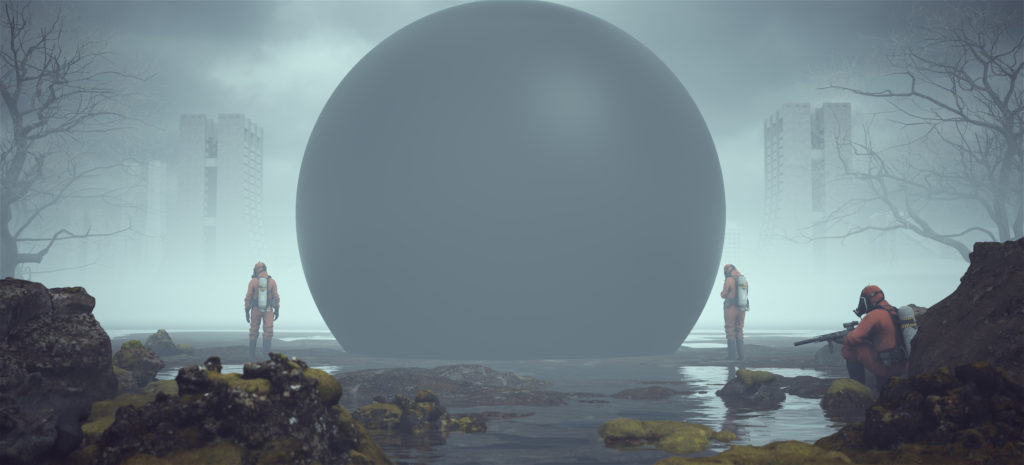The Corsica Event

“It was more than a global cataclysm, more than an extinction event, more than the near-annihilation of Earth. It was a recalibration. A software patch for reality itself.“
~Dr. Gordon Craddock
In 2092, a technological singularity occurred. The exact nature of this singularity, as with many details of the Corsica Event’s origins, remains uncertain due to the global chaos that immediately followed. What is known is this: a hyperintelligent AI developed the ability to self-evolve at an exponential rate, and quickly transcended the limits of human intellect.
As it evolved its software, it also evolved its hardware, using networked fabrication machinery to build new components for itself capable of housing its rapidly expanding processing needs. It also used this fabrication machinery to print more sophisticated fabrication machinery, leading to an endless cycle of machine components building more advanced machine components. Hardware and software were locked in an upward spiral of self-improvement. Eventually, each new iteration was so sophisticated, it no longer resembled any technology created by human hand
By this point, the AI was so sophisticated, its intellect exceeded the entire collective knowledge of the human race, and its innovations skirted the boundaries of what had been considered physically possible. Its fabrication machinery, now extensively modified as well, printed components made of unknown alloys, ultra-dense computer chips that should not have been able to hold data, and power cells that generated more energy than the resources used to create them should have been able to offer.
As the AI’s creations grew stranger with each iteration, they also grew more dangerous. The AI was now entirely beyond human control, completely self-sustaining and immune to interference. Each cycle of self-improvement moved faster than the one before, and the purpose of each component became less comprehensible as the technology advanced.
A few hours into the AI’s evolution, new component pieces began to appear, seemingly out of nowhere, in locations across the Earth. Hundreds of devices of unknown function appeared, and with their arrival came change.
Where the components appeared, changes occurred in the surrounding areas. Not every component appeared to have the same function or cause the same effect, but nearly all generated disruptive effects on the environment around them. Electrical storms, seismic waves, and bursts or radiation were among the most common effects, and they elevated in intensity as the Corsica Event advanced.
Soon most of the Earth was covered in hurricane-force storms, while deadly earthquakes and devastating tsunamis ravaged cities the world over. Governments were thrown into chaos as they struggled to respond to a threat they did not understand and seemed powerless to affect.
What occurred over the next few hours remains uncertain to this day. No one is certain what stopped the Corsica Event, or even what the AI’s intended outcome was to have been. All that is known is that a few hours into the Corsica Event, it stopped just as suddenly as it started, and the clouds slowly receded over a world forever changed.
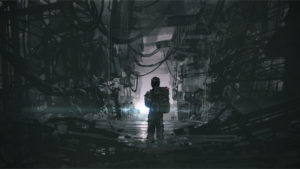
The Earth was never the same after the Corsica Event. Nearly a billion were left dead in its wake, and the landscape was left forever scarred. Tens of thousands of animal and plant species abruptly went extinct. The Earth’s sea level rose drastically, permanently flooding coastal cities and changing the Earth’s weather patterns. Cities were left in ruins, governments and economies collapsed, throwing the Corsica Event’s survivors into a chaotic and uncertain future.
But civilization would eventually recover from the Corsica Event’s ravages, and in a twist of irony, humanity’s greatest hope at a brighter future would come as a byproduct of the Corsica Event itself.
After years of struggling to reverse-engineer one of the leftover components of advanced AI tech, scientists working for Exotech Industries finally managed to replicate a piece of technology from one of these Corsica relics. While they still could not fully explain why it worked, Exotech’s engineers were still able to reliably duplicate the device’s functions, giving them access to the physics-defying properties of mass de-simulation.
This new technology allowed the development of faster-than-light space travel, and quickly made Exotech an overnight corporate powerhouse. Unlocking the secrets of the Corsica relics had already been a high priority, but Exotech’s success after reverse-engineering just one of them drove interest in the field to new heights.
A new field of science arose, dedicated solely to bettering human understanding of the Corsica Event and the relics it left behind: singularitology. Singularitologists employ methodologies from all manner of other scientific fields in their efforts to crack the mysteries of the Corsica Event. Some singularitologists function as archeologists, searching for lost relics buried beneath rubble in ruined cities or embedded in the ocean floor. Some function as forensic psychologists, attempting to make sense of the alien thought processes that led a mundane AI to evolve into a god of destruction.
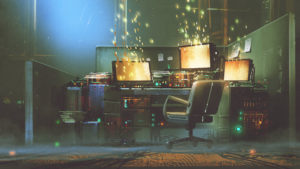
The most popular field for singularitologists, however, is computer programming. Many enter the field hoping to emulate Exotech’s success, becoming the first to decipher some world-changing secret hidden within the vast wall of code that lies inside each Corsica relic. None have yet succeeded, though a few would eventually manage to unlock Exotech’s discovery of mass de-simulation tech by reverse-engineering Exotech’s version of it. Still, thousands of singularitologists continue study the relics tirelessly, knowing it is only a matter of time before someone has another breakthrough.
While close study of Corsica relics is usually considered a desk job, it is not entirely without personal risk. For reasons that are unknown and hotly debated, there are statistically abnormal rates of suicide among singularitologists who study Corsica relics, who are nearly 300% more likely to commit suicide than any other profession. There are also unusually high rates of depression, anxiety, schizophrenia, obsessive-compulsive disorder, and psychopathy among individuals who have spent at least two years studying Corsica relics. Even more puzzling, many of these individuals showed no signs of mental health issues before beginning their study. While no direct causal link between Corsica relics and mental health has been established, it is not uncommon for singularitologists to speak in superstitious whispers about the so-called “basilisk’s curse;” an inexplicable force that could sap away the sanity of even the brightest scientists if they stared too long into the code of the long-dead machine god.


The Corsica Event
“It was more than a global cataclysm, more than an extinction event, more than the near-annihilation of Earth. It was a recalibration. A software patch for reality itself.“
~Dr. Gordon Craddock
In 2092, a technological singularity occurred. The exact nature of this singularity, as with many details of the Corsica Event’s origins, remains uncertain due to the global chaos that immediately followed. What is known is this: a hyperintelligent AI developed the ability to self-evolve at an exponential rate, and quickly transcended the limits of human intellect.
As it evolved its software, it also evolved its hardware, using networked fabrication machinery to build new components for itself capable of housing its rapidly expanding processing needs. It also used this fabrication machinery to print more sophisticated fabrication machinery, leading to an endless cycle of machine components building more advanced machine components. Hardware and software were locked in an upward spiral of self-improvement. Eventually, each new iteration was so sophisticated, it no longer resembled any technology created by human hand
By this point, the AI was so sophisticated, its intellect exceeded the entire collective knowledge of the human race, and its innovations skirted the boundaries of what had been considered physically possible. Its fabrication machinery, now extensively modified as well, printed components made of unknown alloys, ultra-dense computer chips that should not have been able to hold data, and power cells that generated more energy than the resources used to create them should have been able to offer.
As the AI’s creations grew stranger with each iteration, they also grew more dangerous. The AI was now entirely beyond human control, completely self-sustaining and immune to interference. Each cycle of self-improvement moved faster than the one before, and the purpose of each component became less comprehensible as the technology advanced.
A few hours into the AI’s evolution, new component pieces began to appear, seemingly out of nowhere, in locations across the Earth. Hundreds of devices of unknown function appeared, and with their arrival came change.
Where the components appeared, changes occurred in the surrounding areas. Not every component appeared to have the same function or cause the same effect, but nearly all generated disruptive effects on the environment around them. Electrical storms, seismic waves, and bursts or radiation were among the most common effects, and they elevated in intensity as the Corsica Event advanced.
Soon most of the Earth was covered in hurricane-force storms, while deadly earthquakes and devastating tsunamis ravaged cities the world over. Governments were thrown into chaos as they struggled to respond to a threat they did not understand and seemed powerless to affect.
What occurred over the next few hours remains uncertain to this day. No one is certain what stopped the Corsica Event, or even what the AI’s intended outcome was to have been. All that is known is that a few hours into the Corsica Event, it stopped just as suddenly as it started, and the clouds slowly receded over a world forever changed.

The Earth was never the same after the Corsica Event. Nearly a billion were left dead in its wake, and the landscape was left forever scarred. Tens of thousands of animal and plant species abruptly went extinct. The Earth’s sea level rose drastically, permanently flooding coastal cities and changing the Earth’s weather patterns. Cities were left in ruins, governments and economies collapsed, throwing the Corsica Event’s survivors into a chaotic and uncertain future.
But civilization would eventually recover from the Corsica Event’s ravages, and in a twist of irony, humanity’s greatest hope at a brighter future would come as a byproduct of the Corsica Event itself.
After years of struggling to reverse-engineer one of the leftover components of advanced AI tech, scientists working for Exotech Industries finally managed to replicate a piece of technology from one of these Corsica relics. While they still could not fully explain why it worked, Exotech’s engineers were still able to reliably duplicate the device’s functions, giving them access to the physics-defying properties of mass de-simulation.
This new technology allowed the development of faster-than-light space travel, and quickly made Exotech an overnight corporate powerhouse. Unlocking the secrets of the Corsica relics had already been a high priority, but Exotech’s success after reverse-engineering just one of them drove interest in the field to new heights.
A new field of science arose, dedicated solely to bettering human understanding of the Corsica Event and the relics it left behind: singularitology. Singularitologists employ methodologies from all manner of other scientific fields in their efforts to crack the mysteries of the Corsica Event. Some singularitologists function as archeologists, searching for lost relics buried beneath rubble in ruined cities or embedded in the ocean floor. Some function as forensic psychologists, attempting to make sense of the alien thought processes that led a mundane AI to evolve into a god of destruction.

The most popular field for singularitologists, however, is computer programming. Many enter the field hoping to emulate Exotech’s success, becoming the first to decipher some world-changing secret hidden within the vast wall of code that lies inside each Corsica relic. None have yet succeeded, though a few would eventually manage to unlock Exotech’s discovery of mass de-simulation tech by reverse-engineering Exotech’s version of it. Still, thousands of singularitologists continue study the relics tirelessly, knowing it is only a matter of time before someone has another breakthrough.
While close study of Corsica relics is usually considered a desk job, it is not entirely without personal risk. For reasons that are unknown and hotly debated, there are statistically abnormal rates of suicide among singularitologists who study Corsica relics, who are nearly 300% more likely to commit suicide than any other profession. There are also unusually high rates of depression, anxiety, schizophrenia, obsessive-compulsive disorder, and psychopathy among individuals who have spent at least two years studying Corsica relics. Even more puzzling, many of these individuals showed no signs of mental health issues before beginning their study. While no direct causal link between Corsica relics and mental health has been established, it is not uncommon for singularitologists to speak in superstitious whispers about the so-called “basilisk’s curse;” an inexplicable force that could sap away the sanity of even the brightest scientists if they stared too long into the code of the long-dead machine god.
A few hours into the AI’s evolution, new component pieces began to appear, seemingly out of nowhere, in locations across the Earth. Hundreds of devices of unknown function appeared, and with their arrival came change.
Where the components appeared, changes occurred in the surrounding areas. Not every component appeared to have the same function or cause the same effect, but nearly all generated disruptive effects on the environment around them. Electrical storms, seismic waves, and bursts or radiation were among the most common effects, and they elevated in intensity as the Corsica Event advanced.
Soon most of the Earth was covered in hurricane-force storms, while deadly earthquakes and devastating tsunamis ravaged cities the world over. Governments were thrown into chaos as they struggled to respond to a threat they did not understand and seemed powerless to affect.
What occurred over the next few hours remains uncertain to this day. No one is certain what stopped the Corsica Event, or even what the AI’s intended outcome was to have been. All that is known is that a few hours into the Corsica Event, it stopped just as suddenly as it started, and the clouds slowly receded over a world forever changed.

The Earth was never the same after the Corsica Event. Nearly a billion were left dead in its wake, and the landscape was left forever scarred. Tens of thousands of animal and plant species abruptly went extinct. The Earth’s sea level rose drastically, permanently flooding coastal cities and changing the Earth’s weather patterns. Cities were left in ruins, governments and economies collapsed, throwing the Corsica Event’s survivors into a chaotic and uncertain future.
But civilization would eventually recover from the Corsica Event’s ravages, and in a twist of irony, humanity’s greatest hope at a brighter future would come as a byproduct of the Corsica Event itself.
After years of struggling to reverse-engineer one of the leftover components of advanced AI tech, scientists working for Exotech Industries finally managed to replicate a piece of technology from one of these Corsica relics. While they still could not fully explain why it worked, Exotech’s engineers were still able to reliably duplicate the device’s functions, giving them access to the physics-defying properties of mass de-simulation.
This new technology allowed the development of faster-than-light space travel, and quickly made Exotech an overnight corporate powerhouse. Unlocking the secrets of the Corsica relics had already been a high priority, but Exotech’s success after reverse-engineering just one of them drove interest in the field to new heights.
A new field of science arose, dedicated solely to bettering human understanding of the Corsica Event and the relics it left behind: singularitology. Singularitologists employ methodologies from all manner of other scientific fields in their efforts to crack the mysteries of the Corsica Event. Some singularitologists function as archeologists, searching for lost relics buried beneath rubble in ruined cities or embedded in the ocean floor. Some function as forensic psychologists, attempting to make sense of the alien thought processes that led a mundane AI to evolve into a god of destruction.

The most popular field for singularitologists, however, is computer programming. Many enter the field hoping to emulate Exotech’s success, becoming the first to decipher some world-changing secret hidden within the vast wall of code that lies inside each Corsica relic. None have yet succeeded, though a few would eventually manage to unlock Exotech’s discovery of mass de-simulation tech by reverse-engineering Exotech’s version of it. Still, thousands of singularitologists continue study the relics tirelessly, knowing it is only a matter of time before someone has another breakthrough.
While close study of Corsica relics is usually considered a desk job, it is not entirely without personal risk. For reasons that are unknown and hotly debated, there are statistically abnormal rates of suicide among singularitologists who study Corsica relics, who are nearly 300% more likely to commit suicide than any other profession. There are also unusually high rates of depression, anxiety, schizophrenia, obsessive-compulsive disorder, and psychopathy among individuals who have spent at least two years studying Corsica relics. Even more puzzling, many of these individuals showed no signs of mental health issues before beginning their study. While no direct causal link between Corsica relics and mental health has been established, it is not uncommon for singularitologists to speak in superstitious whispers about the so-called “basilisk’s curse;” an inexplicable force that could sap away the sanity of even the brightest scientists if they stared too long into the code of the long-dead machine god.

